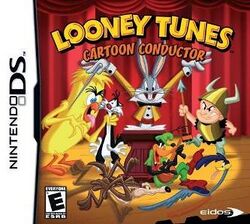Looney Tunes
Topic: Software
 From HandWiki - Reading time: 4 min
From HandWiki - Reading time: 4 min
| Looney Tunes: Cartoon Conductor | |
|---|---|
 North American box art | |
| Developer(s) | Amaze Entertainment |
| Publisher(s) | Eidos Interactive |
| Platform(s) | Nintendo DS |
| Release | |
| Genre(s) | Rhythm |
| Mode(s) | Single-player |
Looney Tunes: Cartoon Conductor (known as Looney Tunes: Cartoon Concerto in Europe and Australia) is a Nintendo DS game developed by Amaze Entertainment and published by Eidos Interactive.
Plot
The game starts with Bugs Bunny standing in front of a stage. Bugs explains that the Tasmanian Devil destroyed the classical music in some old Looney Tunes and Merrie Melodies cartoons, so it's up to the player to conduct a new orchestra to refill the Looney Tunes cartoon background music. Bugs then will teach the player about how to conduct the orchestra.
Gameplay
Players must conduct an orchestra to perform at a classic Looney Tunes cartoon. To start the orchestra, players must tap three times on the touch screen, like a real conductor. To make the orchestra perform perfectly, players must tap or drag the notes at the right times; if not the performance meter will go down. If the performance meter depletes completely, the orchestra will be canceled and the game will end. There are four difficulties: Apprentice (easy), Conductor (normal), Maestro (hard), and a fourth, unlockable mode and the hardest one: Looney. This mode is about as hard as Maestro mode, but unlike the other difficulties, the player must play through the intervals instead of just watching them.
Each time the player taps or drags a note, the player will gain a varying number of points. The number of points depends on the player's accuracy. There are four accuracy levels in the game: Gold, Silver, Normal, and Miss. The score level, scores, and combos also affects the performance meter, the audience, the cartoon, and the musical grade. There are five musical grades: S+, S, A, B and C. The musical grade can be guessed by the amount of applause when the cartoon ends.
Track list
| Melody title | Composer |
|---|---|
| "Orpheus in the Underworld: Can-Can/The Infernal Gallop" | Jacques Offenbach |
| "Flight of the Bumblebee" | Nikolai Rimsky-Korsakov |
| "Ride of the Valkyries" | Richard Wagner |
| "The Planets: Mars, The Bringer of War" | Gustav Holst |
| "Symphony No. 5" | Ludwig van Beethoven |
| "Hungarian Rhapsody No. 2" | Franz Liszt |
| "Carmen: Torreador March" | Georges Bizet |
| "Mexican Hat Dance" | Jesús González Rubio |
| "Toccata and Fugue" | Johann Sebastian Bach |
| "Barber of Seville Overture" | Gioachino Rossini |
| "William Tell Overture" | Gioachino Rossini |
| "Concerto for Two Horns" | Georg Philipp Telemann |
| "The Nutcracker: Dance of the Reed Flutes" (used as a main theme) | Pyotr Ilyich Tchaikovsky |
Voice cast
- Joe Alaskey as Bugs Bunny, Daffy Duck, Sylvester the Cat, Speedy Gonzales, Barnyard Dawg, Marvin the Martian, and Road Runner[1][2][3]
- Bob Bergen as Porky Pig and Tweety Bird[1]
- Jim Cummings as Taz[1]
- Bill Farmer as Foghorn Leghorn and Mouse[1]
- Maurice LaMarche as Wile E. Coyote and Yosemite Sam[1]
- Billy West as Elmer Fudd[1]
Reception
| Reception | ||||||||||||||||||||||||||||||
|---|---|---|---|---|---|---|---|---|---|---|---|---|---|---|---|---|---|---|---|---|---|---|---|---|---|---|---|---|---|---|
| ||||||||||||||||||||||||||||||
Cartoon Conductor received "average" reviews according to the review aggregation website Metacritic.[4]
References
- ↑ 1.0 1.1 1.2 1.3 1.4 1.5 "Looney Tunes Cartoon Conductor" (in en-US). https://www.behindthevoiceactors.com/video-games/Looney-Tunes-Cartoon-Conductor/.
- ↑ "Looney Tunes: Cartoon Conductor (2008) Nintendo DS credits". http://www.mobygames.com/game/nintendo-ds/looney-tunes-cartoon-conductor/credits.
- ↑ "Joe Alaskey interview (Tiny Toon Adventures / Looney Tunes / Who Framed Roger Rabbit)". Saturday Morning Rewind. http://www.saturdaymorningrewind.com/joe-alaskey-podcast-interview.html. "Since 1981, over the past 30 years, I've been doing Bugs, Daffy and the other characters. I'm the only guy in the talent pool who has played all of the major characters, including… yes, including Wile E. Coyote and the Road Runner, but also Porky. You have to hunt for some of these credits, but I have done them all at one point; Hubie and Bertie, and Henery Hawk, all those characters."
- ↑ 4.0 4.1 "Looney Tunes: Cartoon Conductor Critic Reviews for DS". https://www.metacritic.com/game/looney-tunes-cartoon-conductor/critic-reviews/?platform=ds. Retrieved 2014-05-19.
- ↑ Hayward, Andrew (2008-06-17). "Looney Tunes: Cartoon Conductor Review". Archived from the original on 2016-03-04. https://web.archive.org/web/20160304221058/http://www.1up.com/reviews/looney-tunes-cartoon-conductor-review. Retrieved 2014-05-19.
- ↑ 8BitBrian (2008-06-28). "Destructoid review: Looney Tunes: Cartoon Conductor". https://www.destructoid.com/destructoid-review-looney-tunes-cartoon-conductor-92577.phtml. Retrieved 2014-05-19.
- ↑ "Looney Tunes: Cartoon Concerto". GamesMaster: 83. August 2008.
- ↑ Massimilla, Bethany (2008-07-28). "Looney Tunes: Cartoon Conductor Review". http://www.gamespot.com/reviews/looney-tunes-cartoon-conductor-review/1900-6195096/. Retrieved 2014-05-19.
- ↑ "Looney Tunes: Cartoon Concerto". GamesTM: 109. August 2008.
- ↑ Woodward, Stephen (2008-07-08). "Looney Tunes: Cartoon Conductor - NDS - Review". GameZone. Archived from the original on 2008-10-14. https://web.archive.org/web/20081014101429/http://nds.gamezone.com/gzreviews/r35538.htm. Retrieved 2014-05-19.
- ↑ Harris, Craig (2008-08-12). "Looney Tunes Cartoon Conductor Review". http://www.ign.com/articles/2008/08/12/looney-tunes-cartoon-conductor-review. Retrieved 2014-05-19.
- ↑ "Looney Tunes: Cartoon Concerto". Nintendo Gamer: 68. August 2008.
- ↑ "Looney Tunes: Cartoon Conductor". Nintendo Power 230: 90. July 2008.
- ↑ "Looney Tunes: Cartoon Concerto". Official Nintendo Magazine: 99. September 2008.
External links
 |
 KSF
KSF